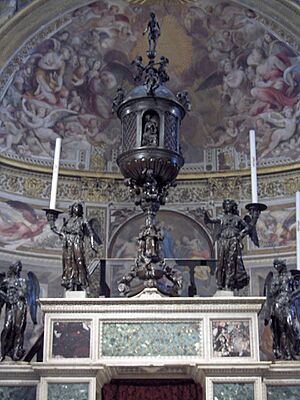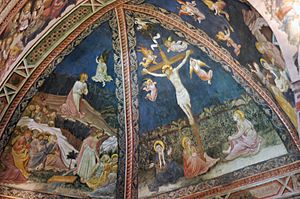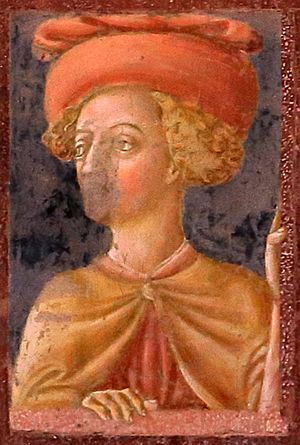Vecchietta facts for kids
Lorenzo di Pietro (born 1410 – died June 6, 1480), also known as Vecchietta, was a talented Italian artist. He lived during the Renaissance period. Vecchietta was a painter, sculptor, goldsmith, and architect. He was from the Sienese School of art, which was a group of artists from the city of Siena.
Many people believe Vecchietta learned from famous artists like Sassetta, Taddeo di Bartolo, and Jacopo della Quercia. Later in his life, Vecchietta taught other artists, including Francesco di Giorgio and Neroccio de’ Landi.
Contents
Vecchietta: The Hospital Painter


Vecchietta was born in Siena, a city in Italy. A lot of his artwork can still be found there. He did much of his work at the Hospital of Santa Maria della Scala. Because of this, people sometimes called him pittor dello spedale, which means "painter of the hospital."
For the Pilgrim Hall (Pellegrinaio) at the Hospital, Vecchietta painted many large pictures on the walls, called frescoes. He worked with other artists like Domenico di Bartolo and Priamo della Quercia. Some of these frescoes showed The Founding of the Spedale and The Vision of Santa Sorore. This last painting showed a dream of the mother of Sorore, who was thought to be the founder of the Hospital.
Around 1444, Vecchietta also decorated the Cappella del Sacro Chiodo, also known as the Old Sacristy, at the Hospital. His frescoes there included scenes like the Annunciation (when an angel told Mary she would have Jesus), the Nativity (the birth of Jesus), and the Last Judgment. He also painted an Allegory of the Ladder, which showed children climbing to heaven. For the main altar of the Church of the Santissima Annunziata, which was inside the Hospital, he made a bronze statue of the Risen Christ in 1476. This statue showed the influence of another famous artist, Donatello.
In 1445, Vecchietta painted a special cabinet called the Arliquiera. This cabinet was used to hold holy relics (important religious items). It was placed in the Old Sacristy of Santa Maria della Scala. Today, you can see it at the National Picture Gallery of Siena.
Other Art in Siena
Vecchietta made a very large bronze ciborium (a container for the Eucharist) for the Hospital of Santa Maria della Scala. This was made between 1467 and 1472. In 1506, it was moved to the main Cathedral of Siena. People admired this work for its beauty and skill.
From 1447 to 1450, Vecchietta and his students painted frescoes in the Baptistry of San Giovanni at Siena Cathedral. These paintings showed the Evangelists (writers of the Gospels), Prophets, and Sibyls (ancient fortune-tellers). They also included scenes from the Four Articles of the Creed and the Assumption of Mary. Many of these frescoes were repainted later in the 1800s. Vecchietta also painted two scenes on the wall behind the altar: Flagellation (Jesus being whipped) and Road to Calvary (Jesus carrying the cross).
At the Palazzo Saracini, Vecchietta created a statue of Saint Martin. He also made a bronze tomb statue of Marianus Soccinus the Elder, who was a famous lawyer from Siena. This statue is now in the Uffizi Gallery in Florence. For the Loggia della Mercanzia, Vecchietta sculpted life-size figures of Saint Peter and Saint Paul around 1458-1460. These statues were praised for how graceful and skillfully they were made. Vecchietta also crafted a silver statue of Saint Catherine of Siena in 1461, when she was made a saint. Sadly, this statue was lost after the siege of Siena in 1555.
Works Outside Siena
Outside of Siena, one of Vecchietta's most important works is a painting called the Assumption. He created this painting in 1451 for a church in Pienza. It was made for Pope Pius II. The Uffizi Gallery in Florence has a painting by Vecchietta of the Madonna, in addition to the bronze statue of Marianus that was moved from Siena.
Vecchietta passed away in Siena on June 6, 1480.
Images for kids
See also
 In Spanish: Vecchietta para niños
In Spanish: Vecchietta para niños





